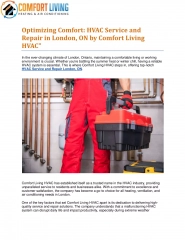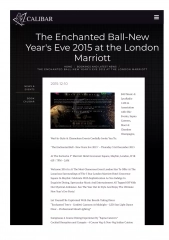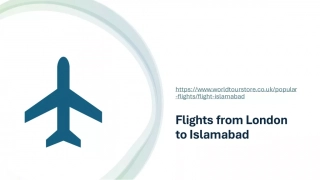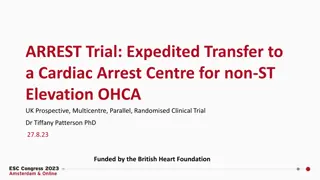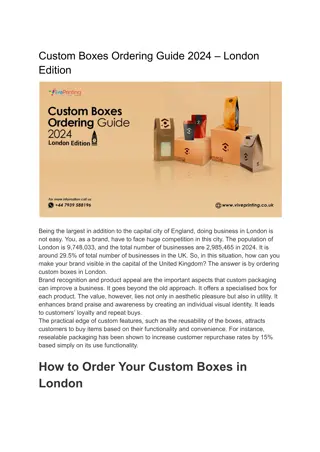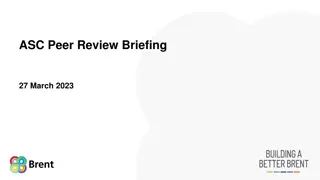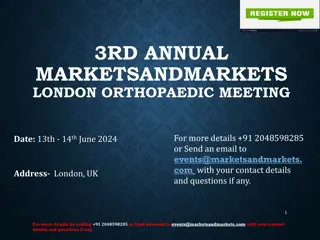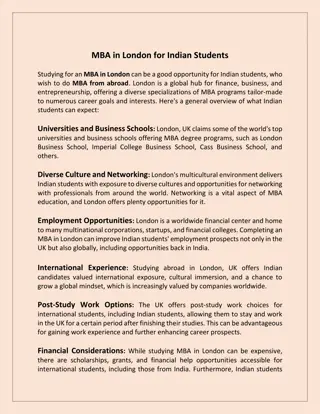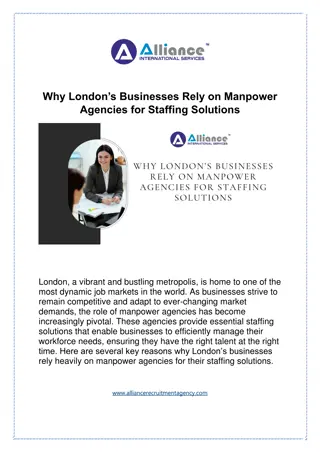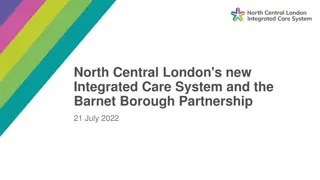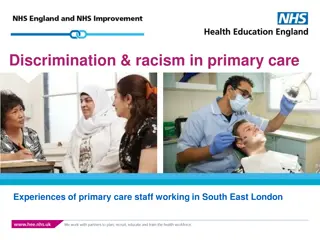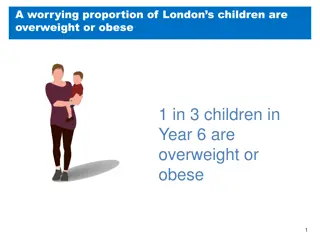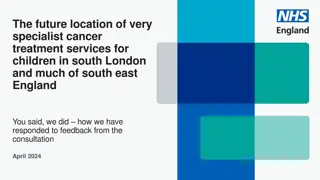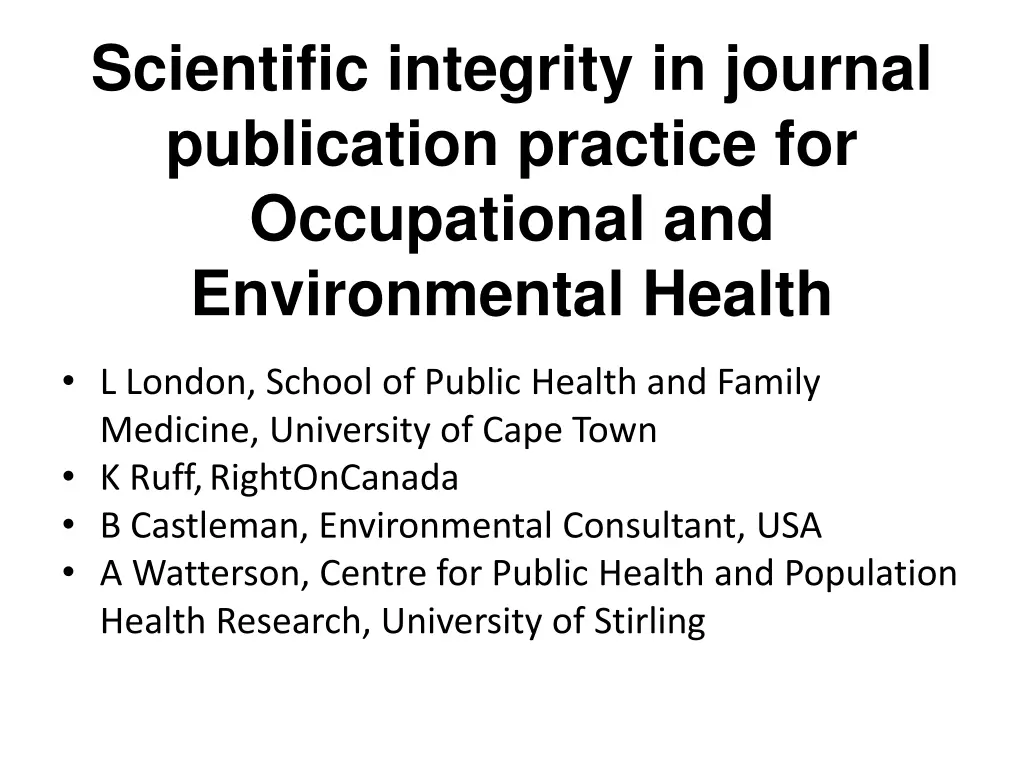
Ensuring Scientific Integrity in Occupational and Environmental Health Journal Publications
Explore the significance of maintaining scientific integrity in journal publications for occupational and environmental health. Learn about the challenges, biases, and measures like COPE guidelines to uphold publication ethics and transparency.
Download Presentation

Please find below an Image/Link to download the presentation.
The content on the website is provided AS IS for your information and personal use only. It may not be sold, licensed, or shared on other websites without obtaining consent from the author. If you encounter any issues during the download, it is possible that the publisher has removed the file from their server.
You are allowed to download the files provided on this website for personal or commercial use, subject to the condition that they are used lawfully. All files are the property of their respective owners.
The content on the website is provided AS IS for your information and personal use only. It may not be sold, licensed, or shared on other websites without obtaining consent from the author.
E N D
Presentation Transcript
Scientific integrity in journal publication practice for Occupational and Environmental Health L London, School of Public Health and Family Medicine, University of Cape Town K Ruff,RightOnCanada B Castleman, Environmental Consultant, USA A Watterson, Centre for Public Health and Population Health Research, University of Stirling
Background Journal publication + rigorous peer-review critical to disseminating new scientific findings Evidence for appropriate public health action. Therefore, publication integrity essential Health policies should be free of vested interests However, increasing pressure on journals from third parties, particularly corporate interests
Research into journal publication bias Friedman and Friedman, 2015: Review of 373 OEH papers in 17 journals 17.2% had a financial COI Articles with financial COI more likely to report null results: If COI involved processing of industrial and commercial products: OR = 4.3 (95% CI (2.5 7.4) If COI with military employers: OR = 9.2 (CI 2.7- 30.7) Resnik reviewed 224 EOH journals in 2017: 96% require COI disclosure 76% defined COI 69% included non-financial disclosure 34% applied COI to editors and reviewers 32% mandated discussion of funding source role 2% enforcement
Where is the firewall? https://www.elsevier.com/__data/assets/pdf_file/0010/92476/ETHICS_COI02.pdf
Committee on Publication Ethics (COPE) Established to provide guidance for editors, journals, publishers Guidelines to New Editors Code of Conduct for Publishers Guideline for Ethical Editing Transparency Guideline on Retraction Relationship of Journal to Research Institutions Journal membership of COPE gives credibility Forum for members to discuss individual cases Receive and deal with complaints
COPE Code of Conduct Duties and responsibilities of editors include: Maintain the integrity of the academic record; Preclude business needs from compromising intellectual and ethical standards;
The International Journal of Occupational and Environmental Health (IJOEH) Long history of peer-reviewed articles critical of industry bias in research Taylor and Francis take over journal in 2015 Existing editor s contract ends Dec 2016 Journal appoints corporate consultant as new editor sans consulting editorial board New Editor associated with Toxicology Excellence for Risk Assessment (TERA) In Feb, Editorial Board wrote to publisher, asked for reasons; pointed to Maier s record on diacetyl
T&F claim Jukka Takala was consulted over direction of journal and new editor Repositioning of journal a result of discussion with Maier how we might position the journal to cover the multiple perspectives of this diverse area with an impartial and evidence-based approach. We felt satisfied that he had the right experience and vision for this role Comment on Retraction Watch: [Yes], The publisher is concerned that the perspective of industrial polluters has been previously neglected T&F note that they retracted previous article (on Bakelite) because it was inadvertently published before the review process was completed, and was subsequently decided to be unsuitable for publication. Three further accepted articles flagged up as raising potential concerns.
What is the article that was unsuitable? Egilman D. The production of corporate research to manufacture doubt about the health hazards of products: an overview of the Exponent Bakelite 2016 22:18-26. New editor denies any involvement in retraction simulation study. IJOEH This content has been removed by the publishers
COPE Guideline What took place? New Editors should honour previous publication decision unless serious problems Decide without interferences from publisher Relationship editor to publisher independent Retraction only if serious: Previous publication withdrawn; 3 more? No reasons given; no evidence serious problems Publisher made decision editor claimed no part in decision Editor unable to exercise independence No evidence of any misconduct, serious error, redundancy, plagiarism, unethical No discussion with author at all Retraction only last resort Editors should champion freedom of expression Preclude business needs from compromising intel standards Keep editorial board members updated on new policies Implied legal/libel issues at stake Implied legal/libel issues at stake T&F repositioned journal as less critical of industry without informing editorial board
Progress? Complaint lodged with COPE June 2nd Follow up inquiries Thank you for your email, I confirm the case has been reviewed by the COPE Complaints subcommittee, the subcommittee is considering the next steps and intends to discuss the matter with the publisher. I will be in touch as the evaluation of the case progresses October 2017 no response T&F
Asbestos and disinfomation in clinical journals
European Journal of Cancer Prevention In May 2012 the European Journal of Cancer Prevention (EJCP) published an article* denying harm caused by continuing exposure to asbestos The authors stated they had no COI and that the article had been funded by the Italian Cancer Research Association Both statements were untrue: Both authors were paid consultants for a company facing criminal charges for continuing asbestos exposure of workers. The Italian Cancer Research Association had not funded the article. Complaint to EJCP (a COPE member) - violated COPE's Code of Conduct Editors responded see no COI; authors reaffirmed no COI March 2014: complaint submitted to COPE for several violations of COPE's Code of Conduct October 2014: COPE upheld the complaint stating that the authors had a COI which should have been declared *La Vecchia C, Boffetta B. Role of stopping exposure and recent exposure to asbestos in the risk of mesothelioma
COPE does not enforce its Code of Conduct COPE recommended that the EJCP publish a Correction to disclose the authors' COI COPE stated that they knew the publisher could ignore the recommendation and there would be no consequences COPE makes recommendations in response to complaints but does not require COPE members to comply In this case, the EJCP published the Correction
The practice of publishing in E&OH PubMed search on occupational , hazards and pesticides to general journal sample. Published 1997; English-language Yield 222 articles from 114 journals Dropped journals with only 1 paper; not English lang Ended with 34 journals (137 articles) Analysis for: COPE membership Editorial independence CoI process Enforcement
COPE adherence Enforcement Membership of COPE: 74% Any specific enforcement measures 15% Editorial independence made explicit: 0% - Erratum:12% Provide for CoI 88% - Retraction: 12% CoI defined financial 88% - Intervene with employer 6% CoI defined non-financial 56% - ban repeat offender 3% Rely on COPE guideline for enforcement 38% Caveats: a) review of websites only limited info; b) website review not contemporaneous with journal article publication
Discussion A set of Failures: failure of conflict of interest processes; failure to enforce corrective action once problems were identified pervasive influence of third parties over editorial decisions non-transparency failure of oversight mechanisms COPE too slow, too weak, no enforcement Yet, usually most journals rely on COPE as members and to take care of enforcement !!
Conclusion Corporate interests continue to threaten the integrity of scientific publication. Failure to keep at bay corporate intrusion into journal publication is a threat to the unbiased dissemination of evidence Threatens the rights of people to enjoy the benefits of scientific progress.


